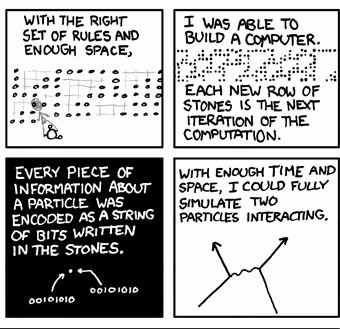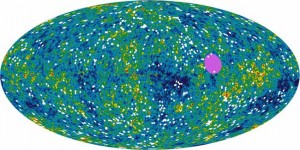Today’s XKCD gets me thinking, as always, about Hitchhiker’s Guide:

Quoth the Guide:
“…we’ll be saying a big hello to all intelligent life forms everywhere … and to everyone else out there, the secret is to bang the rocks together, guys.”
a celebration of science fiction, anime, and geek culture
Today’s XKCD gets me thinking, as always, about Hitchhiker’s Guide:

Quoth the Guide:
“…we’ll be saying a big hello to all intelligent life forms everywhere … and to everyone else out there, the secret is to bang the rocks together, guys.”
Behold, empirical evidence of Something Out There Beyond Our Ken:

Patches of matter in the universe seem to be moving at very high speeds and in a uniform direction that can’t be explained by any of the known gravitational forces in the observable universe. Astronomers are calling the phenomenon “dark flow.”
The stuff that’s pulling this matter must be outside the observable universe, researchers conclude.
There’s a more detailed discussion of this new study at Ars Technica, where they note,
A quartet of researchers measured fluctuations in the CMB that result from the scattering of microwave photons by energetic X-ray emissions from galactic clusters, and discovered a coherent flow of matter across the universe. Dubbed “dark flow” by the team, it cannot easily be explained by the distribution of matter in the visible universe. The team postulates that this motion may be the effect of matter residing outside the CMB—something beyond our ability to directly detect.
[…]
The data used in the paper came from the three year Wilkinson Microwave Anisotropy Probe (WMAP) dataset. Using the WMAP data, the researchers extracted the wavelength of scattered photons from individual galactic clusters. Since the clusters’ motion does not exactly follow the expansion of space-time, these scattering measurements allow researchers to compute the individual motions of each cluster. This is apparent in a very small change in the CMB temperature in the direction the clusters are flowing, a phenomena known as the kinematic Sunyaev-Zel’dovich effect. This technique has a drawback, in that the measurements of this effect for a single cluster have a large statistical errors; to overcome this, the researchers took measurements from over 700 distinct clusters.The velocity of these clusters was computed to be around 2 million miles per hour. Once the part of the movement that is caused by the expansion of the universe was removed, the researchers found a coherent direction to the remaining flow—matter seems to stream towards a region of space between the constellations Centaurus and Vela.
The image above shows the 700 clusters as white dots and the purple spot the general area towards which they are all headed. The autors are repeating the experiment with even more clusters using the 5-year WMAP dataset which should reduce some of the statistical uncertainty involved, but it looks like these results are robust. There really is something out there. And by out “there”, I mean not “here” but an elsewhere that is beyond anywhere that we could ever conceivably call “here”. Woah.
In scifi, FTL is achieved by jumping around spacetime, because accelerating to light speed would require infinite energy (as per Einstein’s Theory of Relativity. Gamma is not your friend). However, now some physicists have theorized a way to accelerate to c and beyond, by “surfing” on a wave of space-time:
In theory, the universe grew faster than the speed of light for a very short time after the Big Bang, driven by the dark energy that represents about 74 percent of the total mass-energy budget in the universe. Dark matter constitutes 22 percent of the budget, and normal matter (stars, planets and everything you see) makes up the remaining 4 percent or so.
Strange as it sounds, current evidence supports the notion that the fabric of space-time can expand faster than the speed of light, because the reality in which light travels is itself expanding.
Cleaver and Richard Obousy, a Baylor graduate student, tapped the latest idea in string theory to devise how to manipulate dark energy and accelerate a spaceship. Their notion is based on the Alcubierre drive, which proposes expanding space-time behind the spaceship while also shrinking space-time in front.
[…]
Cleaver told Space.com, “The dark energy is simultaneously decreased just in front of the ship to decrease (and bring to a stop) the expansion rate of the universe in front of the ship. If the dark energy can be made negative directly in front of the ship, then space in front of the ship would locally contract.”
All you need to do is manipulate the 11th dimension. And it doesn’t even require infinite energy. Just a Jupiter mass or so. Simple!
I’m loath to interject politics or religion here – I already have venues for both elsewhere – but I can’t help my reaction to this:
Is that the face of God? in one sense, yes. That’s the 5-year data from the Wilkinson Microwave Anisotropy Probe (WMAP) and it shows the residual photos from the Big Bang, now cooled down to 2.725 +/- 0.0002 degrees Kelvin. Yeah, the color variations on that scale are only 2/10 thousandths of a degree. But what’s more striking about this is the implication of how much we don’t see:
The energy budget of the Universe is the total amount of energy and matter in the whole cosmos added up. Together with some other observations, WMAP has been able to determine just how much of that budget is occupied by dark energy, dark matter, and normal matter. What they got was: the Universe is 72.1% dark energy, 23.3% dark matter, and 4.62% normal matter. You read that right: everything you can see, taste, hear, touch, just sense in any way… is less than 5% of the whole Universe.
The WMAP data also conclusively demonstrates that the Universe is flat, which has further implications about the inevitable and fundamental limitations of our observational capabilities:
Our successors, whoever and wherever they are, may have no way of finding out about the Big Bang and the expanding universe, according to one of the more depressing scientific papers I have ever read.
If things keep going the way they are, Lawrence Krauss of Case Western Reserve University and Robert J. Scherrer of Vanderbilt University calculate, in 100 billion years the only galaxies left visible in the sky will be the half-dozen or so bound together gravitationally into what is known as the Local Group, which is not expanding and in fact will probably merge into one starry ball.
Unable to see any galaxies flying away, those astronomers will not know the universe is expanding and will think instead that they are back in the static island universe of Einstein. As the authors, who are physicists, write in a paper to be published in The Journal of Relativity and Gravitation, “observers in our ‘island universe’ will be fundamentally incapable of determining the true nature of the universe.â€
Krauss has a piece in Scientific American where he expands on this:
We are led inexorably to a very strange conclusion. The window during which intelligent observers can deduce the true nature of our expanding universe might be very short indeed. Some civilizations might hold on to deep historical archives, and this very article might appear in one—if it can survive billions of years of wars, supernovae, black holes and countless other perils. Whether they will believe it is another question. Civilizations that lack such archives might be doomed to remain forever ignorant of the big bang.
Why is the present universe so special? Many researchers have tried to argue that the existence of life provides a selection effect that might explain the coincidences associated with the present time [see “The Anthropic Principle,†by George Gale; Scientific American, December 1981]. We take different lessons from our work.
First, this would quite likely not be the first time that information about the universe would be lost because of an accelerating expansion. If a period of inflation occurred in the very early universe, then the rapid expansion during this era drove away almost all details of the preexisting matter and energy out of what is now our observable universe. Indeed, one of the original motivations for inflationary models was to rid the universe of pesky cosmological objects such as magnetic monopoles that may once have existed in profusion.
More important, although we are certainly fortunate to live at a time when the observational pillars of the big bang are all detectable, we can easily envisage that other fundamental aspects of the universe are unobservable today. What have we already lost? Rather than being self-satisfied, we should feel humble. Perhaps someday we will find that our current careful and apparently complete understanding of the universe is seriously wanting.
So, that WMAP data above? An ephemeral wisp of data that will fade away. We are fortunate in that sense to be able to see the face of God, because it’s not going to be there forever.
Sometimes I wonder if we really aren’t living in Douglas Adams’ universe after all. Where else, in a Universe where the Ultimate Answer is 42, and the Last Message to Creation is “we apologize for the inconvenience”, would it be true that someday, the Big Bang is destined to someday be a mythological event whose existence will be unprovable by the best available evidence? Will the WMAP data become the icon for Unintelligent Design?